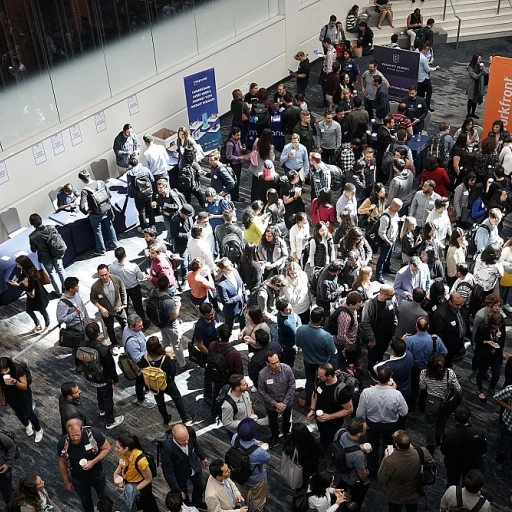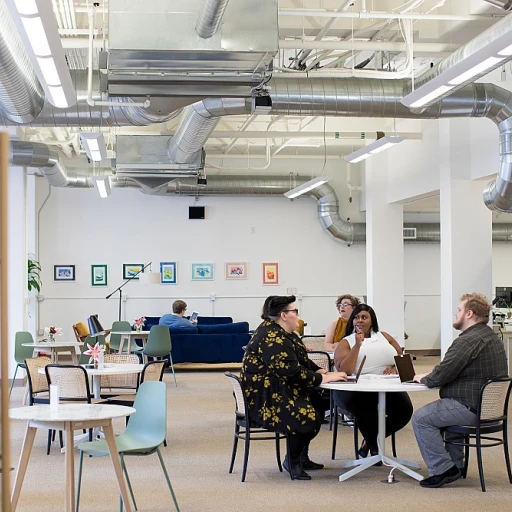Understanding Employee Experience in High-Performing Teams
Decoding the Essence of Employee Experience
In the realm of high-performing teams, understanding the core of employee experience is pivotal. It is not just about the day-to-day tasks employees undertake, but rather the holistic journey they embark on within an organization. This encompasses every interaction team members have with their work environment, leadership, and fellow colleagues.
The Impact on Team Performance
A positive employee experience is a catalyst for high performance. When employees feel valued and engaged, their motivation to achieve team goals and contribute to organizational success increases significantly. This sense of belonging and purpose fuels a culture of high performance, where problem solving and decision making become more effective.
Building a Foundation for Psychological Safety
One of the key elements of a thriving employee experience is psychological safety. In high-performing organizations, team members must feel safe to express their ideas, take risks, and make mistakes without fear of retribution. This environment fosters innovation and encourages employees to push the boundaries of their capabilities, ultimately enhancing team performance.
Long-Term Benefits of a Strong Employee Experience
Investing in a robust employee experience strategy yields long-term benefits for both employees and organizations. It leads to higher employee engagement, reduced turnover, and sustained high performance. For those interested in exploring how enhancing employee experience can foster long-term retention, more insights can be found here.
The Role of Leadership in Shaping Employee Experience
The Influence of Leadership on Employee Engagement
Leadership plays a pivotal role in shaping the employee experience within high-performing teams. The way leaders interact with their team members can significantly influence the overall team culture and performance. Effective leaders understand that their actions and decisions directly impact employee engagement and motivation.
Building Trust and Psychological Safety
One of the key responsibilities of leaders is to foster an environment of trust and psychological safety. When employees feel safe to express their ideas and concerns without fear of negative consequences, they are more likely to contribute to problem solving and decision making. This sense of security is crucial for building high-performing teams where innovation and collaboration thrive.
Aligning Goals and Expectations
Leaders must ensure that the goals and expectations of the organization align with those of the team members. Clear communication of objectives and providing the necessary resources for achieving these goals are essential. When employees understand how their work contributes to the organization's success, they are more engaged and motivated to perform at their best.
Promoting Continuous Development
High-performing organizations prioritize the development of their employees. Leaders should encourage continuous learning and professional growth by providing opportunities for skill development and career advancement. This not only enhances individual performance but also contributes to the overall success of the team.
Encouraging Open Communication
Open and transparent communication is vital for effective leadership. Leaders should regularly seek feedback from their teams and be receptive to their input. By doing so, they can better understand the needs and concerns of their employees, leading to improved employee experiences. For more insights on how feedback shapes employee experience, you can read more here.
In conclusion, the role of leadership in shaping employee experience cannot be overstated. By fostering a supportive and inclusive team culture, aligning goals, promoting development, and encouraging open communication, leaders can significantly enhance the performance and engagement of their teams.
Creating a Culture of Feedback and Recognition
Building a Feedback-Driven Culture
In any organization aiming for high performance, creating a culture where feedback and recognition are integral is essential. This approach not only enhances the employee experience but also fosters a sense of belonging and engagement among team members. Feedback should be seen as a tool for growth, not just a formality. It’s about creating an environment where employees feel heard and valued, contributing to their long-term development and the overall success of the organization.
Encouraging Open Communication
Open communication is a cornerstone of effective feedback. Leaders should encourage team members to share their thoughts and ideas openly. This openness promotes psychological safety, allowing employees to voice concerns and suggestions without fear of reprisal. In turn, this can lead to improved problem solving and decision making, ultimately boosting team performance.
Recognizing Achievements
Recognition is a powerful motivator. When team members are acknowledged for their contributions, it reinforces their value within the team. Recognition should be specific and timely, highlighting how individual efforts contribute to the team’s goals. This practice not only enhances employee engagement but also strengthens the team culture, making employees feel more connected and committed to their work.
Implementing Structured Feedback Mechanisms
To effectively integrate feedback into the organization, structured mechanisms should be in place. Regular check-ins, performance reviews, and informal feedback sessions can be utilized to ensure continuous communication. These mechanisms help in identifying areas for improvement and celebrating successes, thus supporting the development of high-performing teams.
For more insights on how feedback loops can shape positive work experiences, you can explore this resource.
Implementing Flexible Work Arrangements
Embracing Flexibility for Enhanced Team Dynamics
In today's fast-paced work environment, implementing flexible work arrangements has become a cornerstone for enhancing employee experience and boosting team performance. By offering employees the freedom to choose how, when, and where they work, organizations can foster a culture that values autonomy and trust, leading to higher engagement and productivity.
Flexible work arrangements can take various forms, such as remote work, flexible hours, or compressed workweeks. These options allow team members to balance their professional and personal lives more effectively, reducing stress and enhancing overall job satisfaction. When employees feel supported in their work-life balance, they are more likely to contribute positively to the team culture and drive high performance.
Building a Supportive Environment
Leaders play a critical role in shaping a supportive environment where flexible work arrangements can thrive. By promoting psychological safety, leaders encourage team members to voice their needs and preferences without fear of judgment. This open communication is vital for tailoring flexible work options that align with both individual and organizational goals.
Moreover, leaders should focus on performance management strategies that prioritize outcomes over processes. This shift in focus allows employees to leverage their unique strengths and work styles, enhancing team performance and fostering a culture of innovation and problem-solving.
Long-Term Benefits of Flexibility
Adopting flexible work arrangements is not just a short-term solution but a strategic approach to building high-performing teams. When organizations embrace flexibility, they demonstrate a commitment to employee development and engagement, which can lead to improved retention rates and a more resilient workforce.
Ultimately, flexible work arrangements are a key component of a comprehensive employee experience strategy. By integrating flexibility into the organizational culture, leaders can create an environment where team members feel valued and motivated to achieve their best.
Leveraging Technology to Enhance Employee Experience
Integrating Technology for Seamless Workflows
In today's fast-paced work environment, leveraging technology is no longer optional but essential for enhancing employee experience. High-performing teams rely on technology to streamline workflows, boost team performance, and foster a culture of innovation. By implementing the right technological tools, organizations can significantly improve employee engagement and productivity.
Choosing the Right Tools for Your Team
Not all technologies are created equal, and it's crucial for leaders to select tools that align with the organization's goals and the specific needs of their team members. Performance management software, collaboration platforms, and communication tools can enhance team culture by facilitating better decision making and problem solving. These tools should be intuitive and integrate seamlessly into existing systems to avoid disrupting the workflow.
Enhancing Communication and Collaboration
Effective communication is the backbone of high-performing teams. Technology can bridge gaps between team members, especially in flexible work arrangements where employees might be dispersed across various locations. Video conferencing tools, instant messaging apps, and project management software can help maintain a high level of engagement and ensure that all team members are aligned with the organization's objectives.
Promoting Continuous Learning and Development
Technology also plays a pivotal role in employee development. Online training platforms and e-learning modules can provide employees with opportunities to enhance their skills and contribute to the team's high performance. By fostering a culture of continuous learning, organizations can empower employees to reach their full potential and drive long-term success.
Ensuring Data Security and Privacy
While technology offers numerous benefits, it also poses challenges related to data security and privacy. Organizations must implement robust security measures to protect sensitive information and maintain the trust of their employees. Leaders should prioritize transparency and communicate clearly about how data is collected, used, and protected.
In conclusion, technology is a powerful enabler of high performance and employee engagement. By thoughtfully integrating technology into the workplace, organizations can enhance the employee experience and build a foundation for long-term success.
Measuring and Improving Employee Experience
Evaluating the Employee Experience Journey
In any organization aiming for high performance, measuring employee experience is crucial. Without proper evaluation, it's challenging to understand how employees feel about their work environment and whether it supports their growth and engagement. This involves gathering data on various aspects of the employee journey, from onboarding to development opportunities. By consistently assessing these areas, organizations can identify strengths and areas for improvement, ensuring that their teams remain high-performing.
Key Metrics for Success
To effectively measure employee experience, organizations should focus on specific metrics that reflect the overall health of the workplace culture and team dynamics. Some key metrics include:
- Employee Engagement Scores: Regular surveys can help assess how engaged team members are with their work and the organization’s goals.
- Turnover Rates: High turnover can indicate dissatisfaction among employees, pointing to potential issues within the team or leadership.
- Feedback Frequency and Quality: The frequency and quality of feedback provided by leaders and peers can significantly impact employee experiences and team performance.
- Performance Metrics: Assessing individual and team performance helps in understanding how well employees are meeting their goals and contributing to the organization’s success.
Continuous Improvement and Adaptation
Measuring employee experience is not a one-time task but an ongoing process that requires adaptation and continuous improvement. Organizations should be prepared to act on the insights gained from their evaluations. This might involve refining leadership approaches, enhancing feedback mechanisms, or implementing new development programs. Creating a culture of continuous improvement not only boosts team performance but also fosters long-term employee satisfaction and retention.
Building a Feedback-Driven Culture
Creating a culture where feedback is encouraged and valued is essential for improving employee experience. As discussed earlier, feedback plays a critical role in shaping the workplace environment. By fostering open communication and encouraging team members to share their thoughts, organizations can create a more inclusive and supportive culture that enhances both individual and team performance.
Ultimately, the goal is to create a high-performing organization where employees feel valued and motivated to contribute their best. By focusing on these key areas, leaders can ensure their teams are not only performing at their peak but are also engaged and satisfied with their work experiences.








